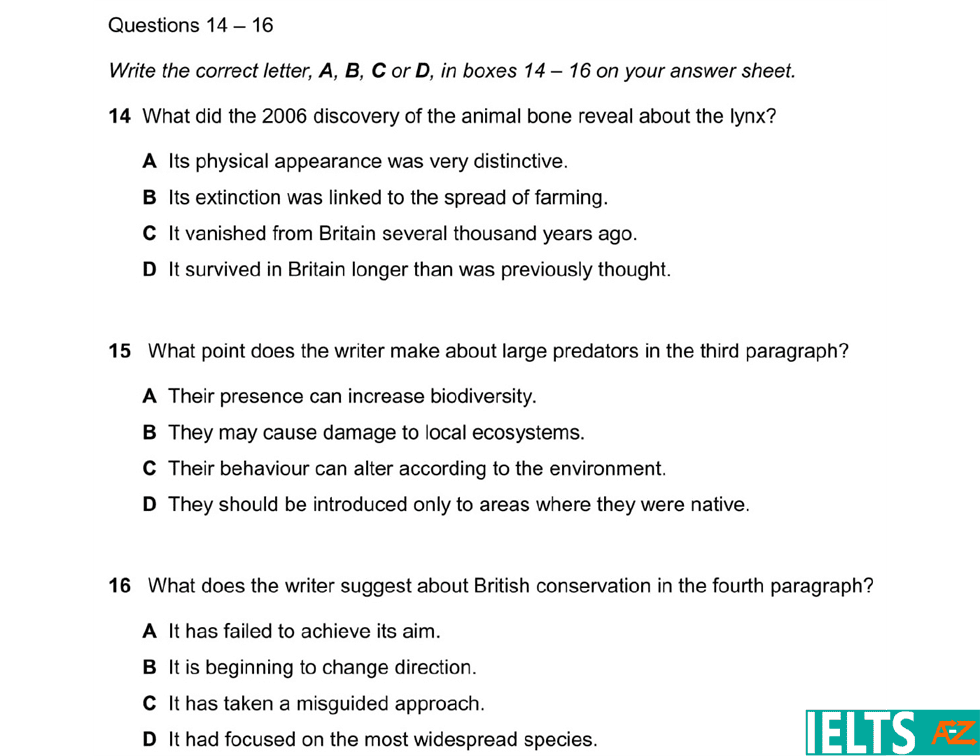IELTS Multiple Choice Questions
In this page we will learn about, What is Multiple Choice?, Example of Multiple Choice Questions, Strategies to answer the questions, Tips for answering the questions, One Paragraph Practice Exercise, Rice That Combats Global Warming Solution and answer discussion.
What is Multiple Choice?
Multiple choices are an answer option for a question. In the IELTS reading, multiple choice identification questions will have you select one or more answers per question. It is essential that you read attentively, as they will show whether you must choose one answer from three or four options.
Example of Multiple Choice Questions:

Strategies to answer the questions:
- Read the first question and underline the important keywords.
- Read the text from beginning to end, scanning for information relevant to the question.
- Once you've identified the important words or their synonyms in the text, look for the answer (it should be somewhere close).
- Once you've found the answer, check the next few lines of text to ensure it's correct. Reread the question as well.
- Repeat this method for the remaining questions, but now read the material from where you left off the last time
Tips for answering the questions:
- Always read the questions first before the passage.
- Most of the time, in MCQs, it tells the question from which paragraph the answer is coming.
- You can cut two options out of four options by yourself only if you think like this. In such a situation, find the difference between the two options in your confusion. Choose the correct answer by matching the meaning well in the passage.
- If you can't find the right answer and time runs out, come up with a guess. In IELTS, there is no negative marking.
- If you do not know anything about the passage, there is nothing to fear. Most students find such passages uncommon. Answers to all questions will be found in the passage. Not everything in the passage is to be understood. Where is the answer to the question in the passage? Just locate that place and answer it with understanding.
- Try to predict the answer by reading the question. If you can do this, you will find the answer quickly.
- Never read the passage before reading the question. because the question asks you to read a specific part of the passage. So reading the passage before means wasting precious time.
- The examiner will try to trap you in various ways. Because the examiner knows that you will look for the answer very quickly, so to trap you where there is no answer to the question, it can give the keyword of the question, and the first part of a sentence will say in the passage in such a way that one of your options matches and you think that is the correct answer. but at the end of that line, using such a contradictory word as "but," however, changes the previous statement of the sentence. So, meanwhile, I will give a very sharp look.
One Paragraph Practice Exercise:
Rice That Combats Global Warming
Rice is consumed on a daily basis by more than half of the world's population. However, rice paddies have a negative impact on the environment as well: they contribute up to 17% of global methane emissions.That is even higher than the emissions from coal mining, which account for 10% of total emissions! As a result, Christer Jansson, a plant scientist at the Pacific Northwest National Laboratory, has spent the last decade developing SUSIBA2, a genetically modified rice plant that releases nearly no methane.
Multiple choice question:
What are the harmful effects of rice?
- It is a staple in the diet of more than half of the world's population.
- Rice paddies release more methane than the coal mining sector.
- Its plantations account for 17% of global methane emissions.
- SUSIBA2, a genetically engineered strain of rice, is unhealthy.
Correct Answer: C
Answer Discussion:
Answer A is correct, but it is the complete opposite of what we are seeking for. The first phrase is that:
" Rice is consumed on a daily basis by more than half of the world's population."
However, it is a positive consequence! And we're on the lookout for the negative one. As a result, this answer is incorrect.
Answer B also provides accurate information, but it is not relevant to the question. Analyze the third sentence, which contains the information used in answer B:
"That is even higher than the emissions from coal mining, which account for 10% of total emissions!"
This statement is used to emphasize the negative effect rather than to state it.
Answer C is correct, the second statement expresses the negative impact clearly:
"However, rice paddies have a negative impact on the environment as well: they contribute up to 17% of global methane emissions."
Answer D is irrelevant. It was never stated that SUSIBA2 is dangerous. This answer employs certain textual terms to confuse you.